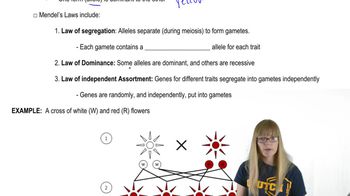Table of contents
- 1. Introduction to Genetics51m
- 2. Mendel's Laws of Inheritance3h 37m
- 3. Extensions to Mendelian Inheritance2h 41m
- 4. Genetic Mapping and Linkage2h 28m
- 5. Genetics of Bacteria and Viruses1h 21m
- 6. Chromosomal Variation1h 48m
- 7. DNA and Chromosome Structure56m
- 8. DNA Replication1h 10m
- 9. Mitosis and Meiosis1h 34m
- 10. Transcription1h 0m
- 11. Translation58m
- 12. Gene Regulation in Prokaryotes1h 19m
- 13. Gene Regulation in Eukaryotes44m
- 14. Genetic Control of Development44m
- 15. Genomes and Genomics1h 50m
- 16. Transposable Elements47m
- 17. Mutation, Repair, and Recombination1h 6m
- 18. Molecular Genetic Tools19m
- 19. Cancer Genetics29m
- 20. Quantitative Genetics1h 26m
- 21. Population Genetics50m
- 22. Evolutionary Genetics29m
15. Genomes and Genomics
Functional Genomics
Problem 30
Textbook Question
Hereditary spherocytosis (HS) is a disorder characterized by sphere-shaped red blood cells, anemia, and other abnormal traits. Ankyrin-1 (ANK1) is a protein that links membrane proteins to the cytoskeleton. Loss of this activity is associated biochemically to HS. However, Gallagher et al. (2010) (J. Clin. Invest. 120:4453–4465) show that HS can also be caused by mutations within a region from -282 to -101 relative to the transcriptional start site, which lead to constitutive transcriptional repression in erythroid cells due to local chromatin condensation. Propose a hypothesis for the function of the -282 to -101 region of the ANK1 gene.
 Verified step by step guidance
Verified step by step guidance1
<span>Step 1: Understand the context of the problem. Hereditary spherocytosis (HS) is linked to mutations in the ANK1 gene, which affect red blood cell shape and function. The problem focuses on a specific region of the ANK1 gene, from -282 to -101, relative to the transcriptional start site.</span>
<span>Step 2: Identify the role of the -282 to -101 region. This region is upstream of the transcriptional start site, suggesting it may be part of the gene's promoter or regulatory region, which controls gene expression.</span>
<span>Step 3: Consider the effect of mutations in this region. Gallagher et al. (2010) found that mutations here lead to constitutive transcriptional repression, indicating that this region normally plays a role in activating transcription in erythroid cells.</span>
<span>Step 4: Hypothesize the function of the region. Given its location and the effect of mutations, propose that the -282 to -101 region contains binding sites for transcription factors necessary for the activation of ANK1 expression in erythroid cells.</span>
<span>Step 5: Suggest further investigation. To test this hypothesis, experiments could be designed to identify specific transcription factors that bind to this region and assess their role in regulating ANK1 expression in erythroid cells.</span>
Recommended similar problem, with video answer:
 Verified Solution
Verified SolutionThis video solution was recommended by our tutors as helpful for the problem above
Video duration:
1mPlay a video:
Was this helpful?
Key Concepts
Here are the essential concepts you must grasp in order to answer the question correctly.
Hereditary Spherocytosis (HS)
Hereditary spherocytosis is a genetic disorder that affects red blood cells, causing them to take on a spherical shape instead of the normal biconcave disc shape. This abnormality leads to increased fragility and hemolysis, resulting in anemia and other complications. Understanding HS is crucial for exploring its genetic basis and the role of specific proteins like Ankyrin-1 in maintaining red blood cell structure.
Recommended video:
Guided course

Mendel's Laws
Ankyrin-1 (ANK1) Function
Ankyrin-1 is a cytoskeletal protein that anchors membrane proteins to the underlying cytoskeleton, providing structural stability to cells, particularly red blood cells. Mutations in the ANK1 gene can disrupt this anchoring function, leading to the characteristic spherocytosis seen in HS. Recognizing the role of ANK1 is essential for understanding the molecular mechanisms underlying the disorder.
Recommended video:
Guided course

Functional Genomics
Transcriptional Regulation and Chromatin Structure
Transcriptional regulation involves the control of gene expression, which can be influenced by the structure of chromatin. The region from -282 to -101 relative to the transcriptional start site of the ANK1 gene is implicated in transcriptional repression, likely due to chromatin condensation. This concept is vital for hypothesizing how mutations in this region could affect ANK1 expression and contribute to HS pathology.
Recommended video:
Guided course

Chromatin

 8:26m
8:26mWatch next
Master Functional Genomics with a bite sized video explanation from Kylia Goodner
Start learningRelated Videos
Related Practice

